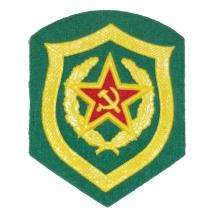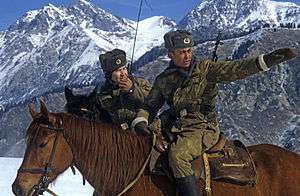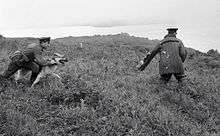Soviet Border Troops


Soviet Border Troops, (Russian: Пограничные войска СССР, Pogranichnyye Voiska SSSR) were the militarized border guard of the Soviet Union, subordinated to its subsequently reorganized state security agency: first to Cheka/OGPU, then to NKVD/MGB and, finally, to KGB. Accordingly, they were known as NKVD Border Troops and KGB Border Troops (with Russian abbreviations - НКВД СССР/- КГБ СССР added on the end of official names). Unlike border guards of many other countries, Soviet Border Troops also included the maritime borderguarding units (i.e., a coast guard).
The mission of the Border Troops included repulsing armed incursions into Soviet territory; preventing illegal crossings of the border or the transport of weapons, explosives, contraband, or subversive literature across the border; monitoring the observance of established procedures at border crossing points; monitoring the observance by Soviet and foreign ships of navigation procedures in Soviet territorial waters; and assisting state agencies in the preservation of natural resources and the protection of the environment from pollution. Border guards were authorized to examine documents and possessions of persons crossing the borders and to confiscate articles; to conduct inquiries in cases of violations of the state border; and to take such actions as arrest, search, and interrogation of individuals suspected of border violations.
They became the Border Service of the Federal Security Service of the Russian Federation on December 30, 1993.
History
In 1934, under the NKVD, Border Troops were immediately subordinated to the GUPVO (abbreviated "Chief Directorate of Border and Internal Guard"). In 1939 they were reorganized into the GUPV ("Chief Directorate of Border Troops").
NKVD Border Troops consisted of infantry, cavalry, reconnaissance, naval and airforce units.
Since the 1920s, the distinctive part of Soviet Border Troops uniform was the medium-green colored parts of headwear and insignia (Russian Empire's Separate Corps of the Border Guard has it distinction since 1893). The color is also present on a maritime Border Troops ensign.
World War II
After the Molotov–Ribbentrop Pact, the Border Troops assisted the pacification of the newly acquired Soviet territory adjoining the state border. The mass execution of Romanian civilians known as the Fântâna Albă massacre happened at this time.
Border Troops units on the western USSR frontier saw particularly fierce combat in the first weeks of the German invasion of the USSR (June–July 1941). They bore the brunt of the initial German assault, and due to this, suffered high casualty rates. Border Troop servicemen were among the defenders of the Brest Fortress. Border troops from other parts of the Soviet border were also involved in the fighting of the war. Notably, the 105th, 157th, and 333rd Border Troops regiments (operating like regular army units) took part in the Battle for Berlin in 1945.
During and after the war, 150 border guards were awarded the title of the Hero of the Soviet Union and over 13,000 of them were decorated with different orders and medals.
Post-War history

In wartime the Border Troops would become a frontline combat service. The Border Troops also saw combat in 1969 in border clashes with Chinese soldiers on islands in the Ussuri River.
After the formation of the KGB, Soviet Border Troops became subordinated to this agency and remained so until the dissolution of the Soviet Union. As such, the Troops were concentrating on the tasks of preventing espionage infiltrations. The Border Guards were involved in the fighting during the Sino-Soviet border conflict and the Soviet war in Afghanistan and a number of them were even awarded the Hero of the Soviet Union for their bravery during these conflicts.
The Soviet border was the longest in the world and it comprised harsh terrain and climates; accordingly the Border Troops employed significant manpower, intensive maritime presence, and a dense and sophisticated system of field engineering devices. The most notable in that system was the trace-control strip (Russian: контрольно-следовая полоса) - a primitive labour-demanding method making surface crossing virtually impossible.
The Border Troops consisted of conscripts drafted by the same system as for the Soviet Army, and small number of professional enlistees. Officers were trained in specialized academies. Both conscripts and officer candidates for Border Troops were carefully selected and checked by the KGB. This made service in the troops privileged.
Commanders of the Soviet Border Guards
- Nikolai Stakhanov, 1942-1952
- Pavel Zyryanov, 1952-1956
- Timofey Strokach, 1956-1957
- Pavel Zyryanov, 1957-1972
- Vadim Matrosov, 1972-1989
- Ilya Kalinichenko, 1989-1991
Legal authority

The legal status, duties, and rights of the Border Troops were set forth in the Law on the State Border, confirmed by the Supreme Soviet on November 24, 1982. Article 28 defined the basic duties of the Border Troops. Their duties included repulsing armed incursions into Soviet territory; preventing illegal crossings of the border or the transport of weapons, explosives, contraband, or subversive literature across the border; monitoring the observance of established procedures at border crossing points; monitoring the observance by Soviet and foreign ships of navigation procedures in Soviet territorial waters; and assisting state agencies in the preservation of natural resources and the protection of the environment from pollution. Border guards were authorized to examine documents and possessions of persons crossing the borders and to confiscate articles; to conduct inquiries in cases of violations of the state border; and to take such actions as arrest, search, and interrogation of individuals suspected of border violations.
Structure
The Border Troops strength was estimated in 1989 to be in the range of 230,000 men. Although under the operational authority of the KGB, the Border Troops were conscripted as part of the biannual call-up of the Ministry of Defense, and their induction and discharge were regulated by the 1967 Law on Universal Military Service, which covered all armed forces of the Soviet Union.[1]
The Border Troops Directorate administered approximately nine border districts (pogranichnye okruga), which covered the nearly 63,000 kilometers of the state border. Border district boundaries were distinct from civil or military district boundaries.[2]
The nine border districts were subdivided into detachments (otriady), covering specific sections of the border, border command posts (pogranichnye komendatury), passport control points (kontrol'no-propusknye punkty), and border outposts (zastavy).[3]
The border area was divided into a border zone, which included the territory of the district and settlements adjacent to the state border, and the border strip, which was approximately two kilometers in depth, running directly along the border. Only permanent residents or those who had obtained special permission from the MVD could enter the border zone. Entry into the border strip was forbidden without special permission from the Border Troops.[4]
The Maritime Border Troops of the Russian Border Troops operated within the twelve-mile limit of Soviet territorial waters. It was equipped with frigates and corvettes, fast patrol boats, hydrofoils, helicopters, and light aircraft.[5]
In 1989 the 103rd Guards Airborne Division, Soviet Airborne Forces, was transferred briefly to the Border Troops.
Training
Enlisted men were trained with their operational units, whereas officers were trained in special Border Troops schools, such as the Dzerzhinskii Higher Border Command School in Alma-Ata (Kazakh SSR) and the Mossovet Higher Border Command School in Moscow. Military-political officers received training at the Voroshilov Higher Border Military-Political School, founded in the 1930s and located outside Leningrad. In 1972 a higher border military-political school was created in Golytsin, near Moscow. More recently, higher border command faculties were set up at the Frunze Military Academy and the Lenin Military-Political Academy. The period of instruction at the Higher Border Command and Military-Political Schools was four years. Officer candidates, who were screened carefully by their local KGB offices before admittance, took general higher education courses along with specialized military and political studies.
Political Considerations
Soviet sources repeatedly stressed that a border guard was not only a soldier but also a defender of Soviet ideology. His mission entailed sensitive political tasks, such as detecting subversive literature. To ensure a high level of discipline among personnel of the Border Troops, much attention was devoted to political training and indoctrination. For this purpose, a network of political organs, the Political Directorate of the Border Troops, was established within the Border Troops. It had political departments within all the border districts, detachments, and education institutions, and a network of full-time party political officers worked among all troop units. They conducted political study groups, gave propaganda lectures, and worked to increase the level of combat effectiveness among the troops.
Famous former Soviet Border Troops
- Alexander Lukashenko, the President of Belarus, served as an officer,
- Mikhail Saakashvili, the President of Georgia, served as a conscript.
- Vlad Filat, the Prime minister of Moldova, served as a conscript.
- Viktor Yushchenko, the 3rd President of Ukraine, served as a conscript.
- Konstantin Chernenko, the second last Soviet leader (Secretary General of the CPSU) also served as a border guard on the USSR-Chinese border, before becoming more involved in politics.
Dissolution and legacy
With the fall of Soviet Union, Border Troops formations in most Soviet republics became border guards of the respective independent states. These new guards mostly changed their name and subordination. The new states of Armenia and Tajikistan are unique exceptions. Tajikistan's border with Afghanistan was guarded by the Russian Border Guard (engaging in heavy fighting) until the late 1990s under a special treaty. Armenia's border is still guarded by Russians under similar conditions.
In Russia and some other post-Soviet states the Border Troops retained some Soviet traditions, most notably the green shoulder boards on their uniforms and "Border Guard's Day" (Russian: День пограничника), an official holiday celebrated both by active service and former border guards.
See also
- Eastern Bloc emigration and defection
- Medal "For Distinction in Guarding the State Border of the USSR"
- Border Guard Service of Russia
- Border Security Zone of Russia
- State Border Guard Service of Ukraine
References
![]() This article incorporates public domain material from the Library of Congress Country Studies website http://lcweb2.loc.gov/frd/cs/.
This article incorporates public domain material from the Library of Congress Country Studies website http://lcweb2.loc.gov/frd/cs/.
- ↑ http://lcweb2.loc.gov/cgi-bin/query/r?frd/cstdy:@field%28DOCID+su0535%29
- ↑ http://lcweb2.loc.gov/cgi-bin/query/r?frd/cstdy:@field%28DOCID+su0535%29
- ↑ http://lcweb2.loc.gov/cgi-bin/query/r?frd/cstdy:@field%28DOCID+su0535%29
- ↑ http://lcweb2.loc.gov/cgi-bin/query/r?frd/cstdy:@field%28DOCID+su0535%29
- ↑ http://lcweb2.loc.gov/cgi-bin/query/r?frd/cstdy:@field%28DOCID+su0535%29
Further reading
- László Békési, György Török: KGB and Soviet Security Uniforms and Militaria 1917-1991 in Colour Photographs, Ramsbury (UK), 2002, ISBN 1-86126-511-5.
External links
- Oral History: A soldiers account of his service in the border guards and NKVD
- NKVD.org: information site about the NKVD